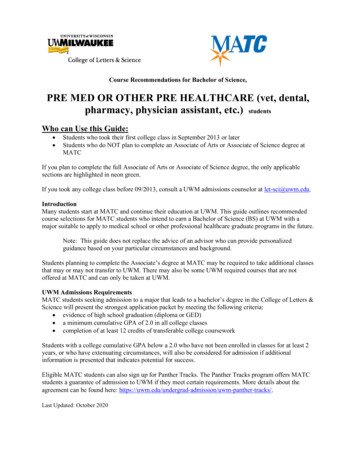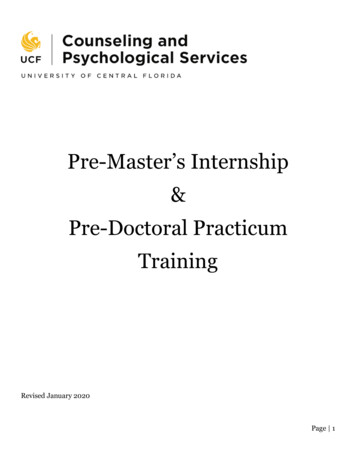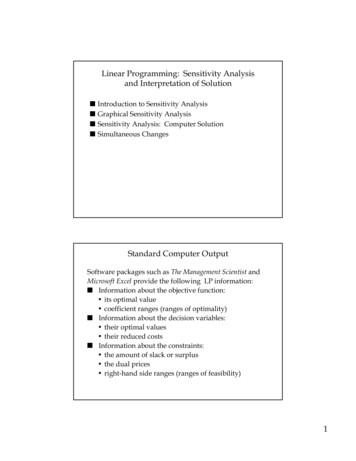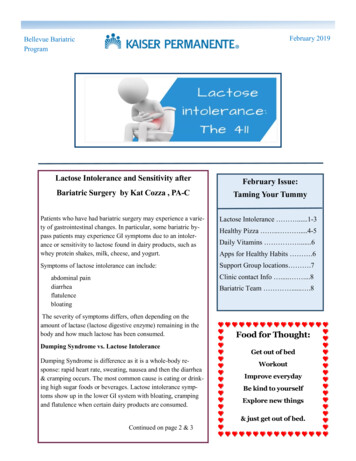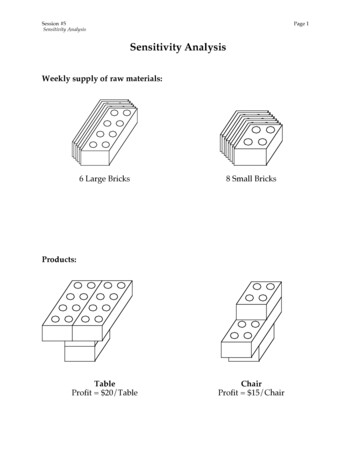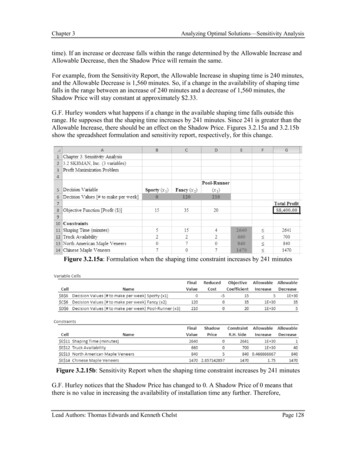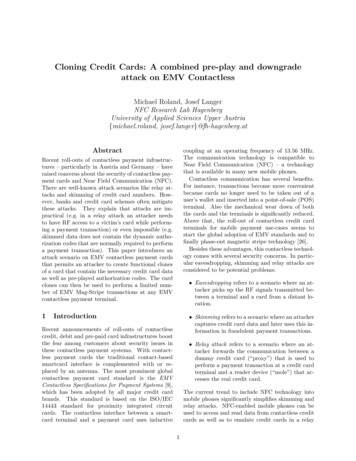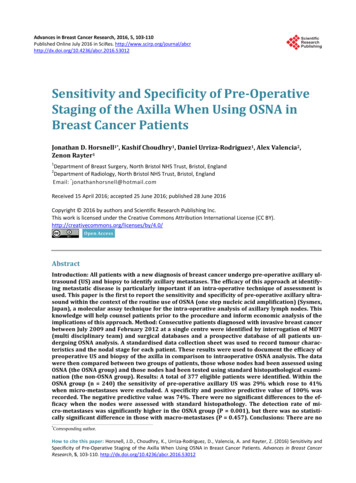
Transcription
Advances in Breast Cancer Research, 2016, 5, 103-110Published Online July 2016 in SciRes. /10.4236/abcr.2016.53012Sensitivity and Specificity of Pre-OperativeStaging of the Axilla When Using OSNA inBreast Cancer PatientsJonathan D. Horsnell1*, Kashif Choudhry1, Daniel Urriza-Rodriguez1, Alex Valencia2,Zenon Rayter11Department of Breast Surgery, North Bristol NHS Trust, Bristol, EnglandDepartment of Radiology, North Bristol NHS Trust, Bristol, England2Received 15 April 2016; accepted 25 June 2016; published 28 June 2016Copyright 2016 by authors and Scientific Research Publishing Inc.This work is licensed under the Creative Commons Attribution International License (CC tractIntroduction: All patients with a new diagnosis of breast cancer undergo pre-operative axillary ultrasound (US) and biopsy to identify axillary metastases. The efficacy of this approach at identifying metastatic disease is particularly important if an intra-operative technique of assessment isused. This paper is the first to report the sensitivity and specificity of pre-operative axillary ultrasound within the context of the routine use of OSNA (one step nucleic acid amplification) (Sysmex,Japan), a molecular assay technique for the intra-operative analysis of axillary lymph nodes. Thisknowledge will help counsel patients prior to the procedure and inform economic analysis of theimplications of this approach. Method: Consecutive patients diagnosed with invasive breast cancerbetween July 2009 and February 2012 at a single centre were identified by interrogation of MDT(multi disciplinary team) and surgical databases and a prospective database of all patients undergoing OSNA analysis. A standardised data collection sheet was used to record tumour characteristics and the nodal stage for each patient. These results were used to document the efficacy ofpreoperative US and biopsy of the axilla in comparison to intraoperative OSNA analysis. The datawere then compared between two groups of patients, those whose nodes had been assessed usingOSNA (the OSNA group) and those nodes had been tested using standard histopathological examination (the non-OSNA group). Results: A total of 377 eligible patients were identified. Within theOSNA group (n 240) the sensitivity of pre-operative axillary US was 29% which rose to 41%when micro-metastases were excluded. A specificity and positive predictive value of 100% wasrecorded. The negative predictive value was 74%. There were no significant differences to the efficacy when the nodes were assessed with standard histopathology. The detection rate of micro-metastases was significantly higher in the OSNA group (P 0.001), but there was no statistically significant difference in those with macro-metastases (P 0.457). Conclusions: There are no*Corresponding author.How to cite this paper: Horsnell, J.D., Choudhry, K., Urriza-Rodriguez, D., Valencia, A. and Rayter, Z. (2016) Sensitivity andSpecificity of Pre-Operative Staging of the Axilla When Using OSNA in Breast Cancer Patients. Advances in Breast CancerResearch, 5, 103-110. http://dx.doi.org/10.4236/abcr.2016.53012
J. D. Horsnell et al.significant differences in the sensitivity and specificity achieved by pre-operative axillary US whencompared to either post operative histopathology or OSNA molecular analysis as the gold standard. OSNA, however, does increase the detection of micro-metastases.KeywordsBreast Cancer, Axillary Metastases, Ultrasound, OSNA1. IntroductionThe assessment of axillary lymph nodes in patients newly diagnosed with breast cancer is a key factor in assessing prognosis and helps guide treatment options and disease management for the individual patient [1]. Guidelines within the United Kingdom recommend that all patients with a new diagnosis of breast cancer undergo ultrasound (US) examination of their axillae with a guided biopsy of any suspicious nodes prior to their primarysurgery [2]. Sentinel lymph node biopsy (SLNB) has become the standard of care for the analysis of patientswith a clinical and ultrasound negative axilla whilst an axillary clearance remains the favoured approach forthose patients found to have a positive node pre-operatively. The sensitivity of US, in this context, has been reported to range from 25% - 63% with specificities of up to 100% [1]. These results are based on the comparisonof ultrasound to traditional gold standard post-operative histopathological assessment of the sentinel nodes.In some centres the use of intra-operative methods of lymph node assessment is favoured. The advantages ofintra-operative lymph node assessment include a reduction in patient anxiety, the avoidance of a second operative procedure if the nodes are positive, and a subsequent reduction in the use of healthcare resources [3] [4]. Anumber of techniques have been used in this setting. These include frozen section analysis, touch imprint cytology and molecular analysis. The sensitivity and specificities of these techniques vary with 57% - 74% sensitivityand 100% specificities reported for frozen section [3] [5], 63% sensitivity and 99% specificity for touch imprintcytology [6] and sensitivities of between 95% - 98% with specificities of up to 97% for molecular assays [6].Tests which utilise molecular assays use either reverse transcriptase polymerase chain reactions (RT-PCR) orreverse transcriptase loop-mediated isothermal amplifications (RT-LAMP). These have been developed to detectmetastasis by quantitatively measuring the concentration of tumour specific mRNA markers. One of the distinctdifferences between the molecular assays and traditional pathological techniques is that the whole node is homogenised as part of the process. As a result post-operative histopathological assessment cannot take place.Further it is possible that small metastases not previously identified by standard histopathology may be detected.Previous work has demonstrated that increasing interrogation of lymph nodes, histologically, using a 2 mm stepsectioning protocol upstaged between 7% and 42% of cases when compared to a single section and that the useof OSNA increases the rate of detection of micro-metastases [7] [8].A disadvantage of the use of intra-operative testing is that it can add extra time to the operation. This mightoccur due to a wait for the test result or because of the extra surgery needed (an axillary clearance) if the node isfound to harbour metastatic disease. Previous work has demonstrated that waiting for the results may add up to20 minutes to the length of a wide local excision and sentinel lymph node biopsy with further added time if anaxillary clearance is required [9]. This could significantly impinge on the planning and completion of the operating list. Identification of patients with axillary disease pre-operatively helps reduce this risk, thus an appreciation of the efficacy of pre-operative ultrasound of the axillae is vital. All previous work has used histopathological assessment of the node as the gold standard.Within the breast surgery unit at our institution a protocol has been adopted that includes the use of both preoperative US followed by either fine needle aspiration (FNA) or core biopsy and intra-operative OSNA (Sysmex, Japan) assessment of any nodes that are clinically and radiologically negative. This is the only molecularassay currently available commercially. It has been adopted by a number of UK centres, including our own andhas recently been approved for use by the National Institute for Clinical Excellence (NICE) in the UK [9] [10].The technique utilises the RT-LAMP methodology to quantify the expression of cytokeratin-19 (CK-19) withinthe axillary nodes [11]. The impact that this has on the sensitivity and specificity of pre-operative ultrasoundexamination of the axillae has not been previously explored and this paper is the first to document the impact104
J. D. Horsnell et al.that the use of OSNA has in this context.The primary aim of this study was to report the efficacy of pre-operative US assessment of the axillae when using OSNA as the gold standard comparison. Secondary outcomes included a comparison of these results to thoseachieved using standard post-operative histopathological testing. Further this would allow the incidence of macro-metastases and micro-metastases to be compared in these two scenarios for a consecutive series of patients.2. MethodsA prospective database of consecutive patients, the “OSNA group” diagnosed with primary breast cancer withinour institution was created for all patients undergoing sentinel node biopsy and OSNA lymph node analysis (July 2010 to February 2012). A retrospective case note and electronic systems review was performed to create asecond database, the “non-OSNA group” of all primary breast cancer patients who underwent surgery for a yearprior to the full implementation of sentinel node biopsy and intra-operative testing (July 2009 to July 2010).All patients who underwent an ultrasound at the time of initial diagnosis and subsequent axillary clearancewere identified based on multi-disciplinary team (MDT) databases, radiological reporting systems, operatingrecords and diaries. At the time of initial presentation all patients underwent clinical breast examination, radiological investigation and either a core biopsy or FNA of any suspicious areas within the context of a one stopclinic at a single university teaching hospital. For any patient in which there was a diagnosis of breast cancer anultrasound of the axilla was performed by a consultant radiologist, with an FNA or core biopsy of any abnormalnodes. If, on examination by a consultant pathologist, there was evidence of metastatic disease then the patientunderwent an axillary clearance as their primary axillary surgery. If the node was negative on ultrasound with orwithout biopsy then the patient underwent a sentinel lymph node biopsy. For patients undergoing surgery beforefull OSNA implementation, post-operative histopathological assessment was performed. For all patients presenting after July 2010 intra-operative OSNA assessment at the time of their primary surgery was carried out.All patients who received neo-adjuvant treatment were excluded from the study.Patients having a SLNB attended the nuclear medicine department not more than 24 hours prior to surgery fora sub-dermal injection of a radioactive isotope (Nanocoll, G.E. Healthcare, Chicago, USA). Immediately prior tosurgery each patient received a peri-areolar injection of 2 ml of 2.5% Patent V Blue dye (Guerbet, Roissy,France) based on the position of their tumour, followed by 5 minutes of breast massage. A gamma probe wasthen employed to guide the position of the incision and subsequent dissection of the sentinel lymph nodes. Following excision all radioactive and blue nodes were denuded of surrounding fat and either submitted for histopathological analysis or sent for intra-operative analysis using OSNA. The OSNA assay was performed in aseparate room adjacent to the operating theatre. The SLNB was performed immediately prior to the breast surgery, which continued whilst the OSNA test took place. The results were then conveyed to the operating surgeonprior to the patient being woken from anaesthesia. If the node was negative (copy number 250 μL CK19mRNA) then no further axillary surgery was performed. If the node was positive for macro-metastases (copynumber 5000 μL) or micro-metastases (copy numbers 250 - 5000 μL) then an immediate axillary clearance wasperformed and the further nodes excised were sent for histopathological assessment. All patients were consentedfor this possibility. At the start of the study the finding of micro-metastases was followed by an immediate axillary clearance. However following local audit, supported by the results of the IBCSG 23-01 trial and the recentSt Gallen consensus [12] [13], this practice was discontinued and only patients positive for macro-metastaseswent on to have an axillary clearance.Statistical analysis was performed using GraphPad software (GraphPad Inc., La Jolla, USA). A t-test wasused for continuous data, and either a Fishers exact test or Chi squared test was used for categorical data. Detailsof which test were used are given in the tables that present the data.3. Results276 patients with a new diagnosis of primary invasive breast cancer were included in the prospective database ofall patients undergoing SLNB and OSNA. 36 were excluded from this study as they had received neo-adjuvantchemotherapy, thus 240 patients were included in the “OSNA group”. 165 patients who had undergone SLNBwithout intra-operative testing were identified by retrospective review. 28 of these patients were excluded fromthis study as they had either received neo-adjuvant chemotherapy (n 9) or had not received a pre operativeaxillary ultrasound (n 19). A total of 137 patients were therefore included in the “non-OSNA” group.105
J. D. Horsnell et al.3.1. Patient CharacteristicsThe patients in each of these groups were not selected but represented a consecutive series of patients presentingto the department. As expected there were no significant differences in the age, tumour grade or size in eithergroup (Table 1).3.2. Sensitivity and Specificity of Pre-Operative Ultrasound Scans23 patients (10%) in the OSNA group had a positive lymph node identified pre-operatively using axillary ultrasound and biopsy. All of these patients were found to have macro metastases at axillary clearance. Of the remaining 217 patients undergoing a SLNB, 161 (74%) had a negative axilla and 56 (26%) had evidence of positive sentinel nodes. Of these 56 patients 23 had micro-metastases and 33 had macro-metastases (Figure 1).In comparison to OSNA as the gold standard the sensitivity of pre-operative ultrasound for identifying microand macro-metastases disease was 29% and for identifying macro-metastases was 41%. The specificity and positive predictive value was 100%, with a negative predictive value of 84% for macro-metastases and 74% forboth micro- and macro-metastases (Table 2).9 (7%) of the non-OSNA group had a positive axilla identified before surgery, all of which were found tohave macro-metastases. Of the remaining 128 patients in this group 98 (77%) had a negative axilla at subsequentFigure 1. Flow chart demonstrating the outcomes of tests for patients with a new diagnosis ofbreast cancer that they underwent following their initial pre-operative ultrasound scan.Table 1. Demographic details of the patients in each group demonstrating patients age, tumour grade and size and totalnumber of involved nodes (SD standard deviation).Non-OSNA Group (n 137)OSNA Group (n 240)1) Age (mean in years / SD)60.8 ( / 12)61.4 ( / 12)P 0.642*2) Tumour Grade (mode)22P 0.58**3) Tumour Size (mean in mm / SD)18.9 ( / 11.1)16.9 ( / 10.7)P 0.1*4) Total Nodes Involved (mean / SD)0.77 ( / 2.5) (range 0 - 23)0.86 ( / 2.5) (range 0 - 23)P 0.74**using unpaired t-test, **using Chi-squared test.106
J. D. Horsnell et al.Table 2. The sensitivity, specificity, positive predictive value (PPV) and negative predictive value (NPV) of US and FNA orcore biopsy in comparison to OSNA and histopathology (for those proceeding direct to axillary dissection) at detecting allaxillary metastases (micro and macro-metastases, Table 2a) and macro-metastases alone (Table 2b) in patients undergoingsurgery for primary breast cancer.(a)Final StatusUltrasound FNAMicro- or Macro-metastasesNegativeMicro- or Macro-metastases230PPV 100%Negative56161NPV 74%Sensitivity 29%Specificity 100%(b)Final StatusUltrasound FNAMacro-metastasesNegativeMacro-metastases230PPV 100%Negative33184NPV 84%Sensitivity 41%Specificity 100%primary axillary surgery and 30 (23%) had at least one positive node identified. Of those 30 patients, 28 hadmacro metastases and 2 had micro-metastases (Figure 1).In comparison to standard histopathology assessment of the nodes as the gold standard, the sensitivity ofpre-operative ultrasound was 23% for both micro and macro metastases, and 29% for macro metastases alone.The specificity and positive predictive value was 100% with a negative predictive value of 79% for macro-metastases (Table 3).3.3. Comparison between the Two Groups3.3.1. Effectiveness of Pre-Operative Ultrasound Scan and BiopsyA Fishers exact test was used to compare the effectiveness of pre-operative US and biopsy when compared toeither OSNA or post operative histopathology as the gold standard. There were no statistically significant differences in the sensitivity for patients with positive nodes (including micro-metastases and macro-metastases) orthe sensitivity for macro-metastases alone. Further the differences in the specificity, positive predictive values,and negative predicative values were also not statistically significant (Table 4).3.3.2. Final Axillary StatusThere were no statistically significant difference between the two groups in the number of patients diagnosedwith metastatic disease prior to surgery (23/240 in the OSNA Group vs. 9/137 in the non-OSNA group P 0.34).When comparing the final status of the axilla, there was a higher rate of micro-metastases in the OSNA group incomparison to that picked up by standard histopathology in the non-OSNA group (23/230 vs. 2/137) which wasstatistically significant (P 0.001, Fishers exact test). Amongst those who were US negative there were morepatients with macro-metastases in the non-OSNA group which demonstrated a trend towards significance(33/217 vs 28/128, P 0.14) (Table 5).4. DiscussionsThe use of SLNB has become the standard of care for patients with a new diagnosis of breast cancer. Identification of lymph node metastases prior to surgery can allow for an immediate axillary clearance to take placewithout the need for a SLNB first. The primary aim of this study was to document the sensitivity, specificity andthe positive and negative predictive values of pre-operative US and biopsy within the context of OSNA use.These results confirm the efficacy of this approach with no significant differences between the results obtainedwhen using OSNA or post operative histopathology as the gold standard. An understanding of these results107
J. D. Horsnell et al.Table 3. The sensitivity, specificity, positive predictive value (PPV) and negative predictive value (NPV) of US and FNA orcore biopsy at detecting all axillary metastases (micro and macro-metastases, Table 3a) and macro-metastases only (table3b) in patients undergoing surgery for primary breast cancer in comparison to histopathology.(a)Post Operative HistopathologyUltrasound FNAMacro-metastasesNegativeMicro- or Macro-metastases90PPV 100%Negative3098NPV 77%Micro- or Macro-metastases9(b)Post Operative HistopathologyUltrasound FNAMacro-metastases)NegativeMacro-metastases90PPV 100%Negative28100NPV 78%Sensitivity 26%Specificity 100%Table 4. A comparison of the sensitivity, specificity, positive predictive value (PPV) and negative predictive value (NPV)achieved by pre-operative US and FNA or core biopsy when compared to either histopathology or intra-operative OSNAanalysis and histopathology (for those who had pre-operative positive nodes) in the two groups of patients.Non-OSNA groupOSNA group(All Fishers Exact Test)Micro- and Macro-metastasesSensitivity23%29%P 0.82Specificity100%100%P 1Positive Predictive Value100%100%P 1Negative Predictive Value77%74%P 0.7Non-OSNA groupOSNA groupMacro-metastases onlySensitivity26%41%P 0.12Specificity100%100%P 1Positive Predictive Value100%100%P 1Negative Predictive Value78%84%P 0.14which show that 1 in 7 patients with a negative axillae will go on to have a macro metastases can help counselpatients undergoing this procedure and inform planning of the operating list. Further this information can beused to support the economic modelling
OSNA (the OSNA group) and those nodeshad been tested using standard histopathological exam i-nation (the non-OSNA group). Results: A total of 377 eligible patients were identified. Within the OSNA group (n 240) the sensitivity of pre-operative axillary US was 2
